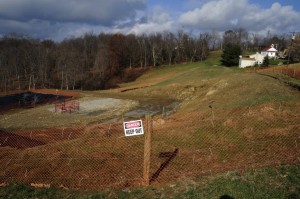By Jenny Vickers, New Jersey Communications Coordinator and Organizer
In just a few days the Delaware River Watershed could be opened up to a controversial method of natural gas extraction –
hydraulic fracturing – putting the drinking water for 15 million people, including 3 million in New Jersey at risk.
On Monday, November 21, the Delaware River Basin Commission (DRBC), consisting of the governors of Delaware, Pennsylvania, New York and New Jersey, plus Army Corps of Engineers which represents the federal government, will vote on
proposed rules that would lift a moratorium and allow tens of thousands of gas wells to be drilled in the basin.
Due to numerous environmental and safety concerns about hydraulic fracturing and new
scientific evidence linking natural gas drilling with methane contamination of drinking water wells, the
New Jersey Environmental Federation, the NJ Chapter of Clean Water Action, joins the
35,000+ others in urging the DRBC to keep the moratorium on fracking in place until further cumulative impact and environmental studies can be done.
Hydraulic fracturing (aka fracking) involves blasting water, chemicals and sand deep into underground rock formations to unlock the natural gas they contain. Although the gas drilling industry claims the process is safe, we believe the risks to our water, health, and land are greater than the industry admits.
On May 9, for the first time,
a scientific study has linked natural gas drilling and fracking with a pattern of drinking water contamination so severe that some faucets can be lit on fire. The study, which was conducted by scientists at Duke University and published in the
Proceedings of the National Academy of Sciences, found that levels of flammable methane gas in drinking water wells increased to dangerous levels when those water supplies were close to natural gas wells.
Methane contamination of drinking water wells has plagued people living in gas drilling areas across the country. In several cases, homes blew up after gas seeped into their basements or water supplies. In the town of
Dimock, Pennsylvania, 13 water wells were contaminated with methane (one of them blew up), and the gas company, Cabot Oil & Gas, had to financially compensate residents and construct a pipeline to bring in clean water. In
Allentown, Pennsylvania, a 2004 accident killed three people, including a baby.
In 2006, drilling fluids and methane were detected leaking from the ground near a gas well in
Clark, Wyoming; 8 million cubic feet of methane were eventually released, and shallow groundwater was found to be contaminated.
Fracking also has the potential to pollute water supplies with potentially hazardous chemicals, including known carcinogens. The fracking process uses a toxic chemical cocktail known as fracking fluid. Companies using fracking fluid have resisted disclosing its contents, claiming the information is proprietary. However,
samples from well sites indicate that the fluid contains formaldehyde, benzene, acetic, citric and boric acids, among hundreds of other toxic contaminants. It has recently come to light that, despite the illegality of the action, companies have been caught using
diesel fuel in the fracking fluid.
In
Dish, Texas, elevated levels of disulphides, benzene, xylenes and naphthalene have been detected in the air, alongside numerous local complaints of headaches, diarrhea, nosebleeds, dizziness, muscle spasms and other problems. In
Garfield County, Colorado, another area with a high concentration of drilling rigs, volatile organic compound emissions increased 30% between 2004 and 2006; during the same period there was a rash of health complaints from local residents.
Fracking also wastes precious freshwater resources. By far and away the biggest component of
fracking fluids is fresh water. The initial drilling operation may consume from 65,000 to 600,000 gallons of locally-sourced freshwater. Over its lifetime, each well will use an additional two to five million gallons which will be permanently contaminated by ground contaminants and toxic chemicals contained in the fracking fluid. About half of this water returns to the surface, where it is stored in steel containers until it can be injected deep underground in oil and gas waste wells.
No one is entirely sure what happens to the other half of the water used in the process. Our best guess is that the water remains underground, though there are
indications that at least some of this toxic cocktail makes its way back into the water supply.
The bottom line is this: the discovery of new gas resources shouldn’t come at the expense of public health and our environment, no matter how many jobs are created. In November, a
federal advisory panel issued a report warning that "serious environmental consequences" could result from fracking if steps aren't taken to reduce its impacts. In the report, published on November 10, the panel said that progress by the federal government and the oil and gas industry on 20 recommendations it issued in August has been less than it hoped.
The stories above provide eye-opening evidence about the risks hydfrofracking poses to our water resources. Tell Governor Christie to put our health, public safety, and water above gas industry profits and vote against fracking in the Delaware River Basin. To take action on this issue and find out how you can attend the "Don't Drill the Delaware Day" - a rally and march being held Monday, November 21 at the War Memorial in Trenton, visit
www.cleanwateraction.org/njef.
Jenny Vickers is the Communications Coordinator for the NJ Environmental Federation, the NJ Chapter of Clean Water Action, an organization that has been fighting for more than 36 years to protect our water, the health of our families from toxics and environmental injustices, as well as make democracy work. www.cleanwateraction.org/njef



